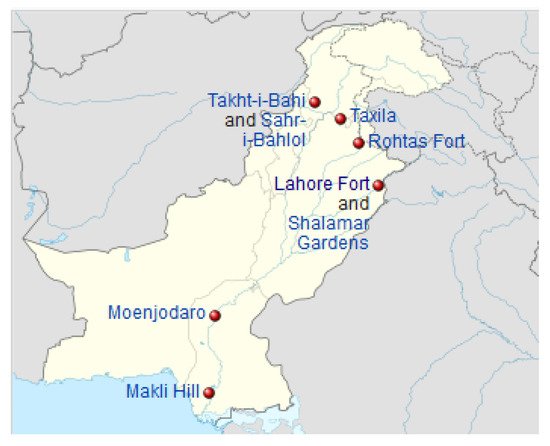Architectural heritage includes built structures that are of outstanding value of natural and cultural identity and require conservation, preservation, presentation and transmission to the future generations. In this regard, UNESCO has enlisted six World Heritage Sites in Pakistan that need to be preserved. Moreover, the heritage sites are undergoing theft, vandalism, natural decay and other socio-cultural harms. One of the state-of-the-art methodologies is the digital preservation of the historic sites. Amongst the various available computer technologies, photogrammetry is the quickest and most cost-effective method that can be used for digital preservation. The research will focus on the digital preservation of UNESCO World Heritage Sites, which is an emerging trend in an architectural context. Developing countries have limited funds and resources and most historic sites are being neglected by the lack of financial resources. The paper suggests digital preservation as an emerging solution, identifies its challenges and suggests photogrammetry as a cost-effective solution to six UNESCO enlisted historic sites of Pakistan. It also suggests that once digitally recorded, information of historic sites can also be used in diverse applications to generate further finances.
- digital heritage
- UNESCO
- conservation challenges
- photogrammetry
- architectural heritage
1. Introduction
1.1. Digital Heritage
1.2. Historical, Natural and Cultural Heritage of Pakistan

2. Photogrammetry, a Quick Resource of Digital Preservation
3. Diverse Application of Digital Preservation
References
- Remondino, F. Heritage recording and 3D modeling with photogrammetry and 3D scanning. Remote Sens. 2011, 3, 1104–1138.
- Tweed, C.; Sutherland, M. Built cultural heritage and sustainable urban development. Landsc. Urban Plan. 2007, 83, 62–69.
- Gullino, P.; Beccaro, G.L.; Larcher, F. Assessing and monitoring the sustainability in rural world heritage sites. Sustainability 2015, 7, 14186–14210.
- Merino-Aranda, A.; Castillejo-González, I.L.; Velo-Gala, A.; Montes-Tubío, F.D.P.; Mesas-Carrascosa, F.J.; Triviño-Tarradas, P. Strengthening efforts to protect and safeguard the industrial cultural heritage in montilla-moriles (Pdo). characterisation of historic wineries. Sustainability 2021, 13, 5791.
- Hernàndez-Cardona, F.X.; Sospedra-Roca, R.; Íñiguez-Gracia, D. Educational illustration of the historical city, education citizenship, and sustainable heritage. Sustainability 2021, 13, 5706.
- Bob Giddings, B.H.; O’brien, G. Environment, economy and society: Fitting them together into Sustainable Development. Sustain. Dev. 2002, 10, 187–196.
- 7. Erica Avrami, Randall Mason, Marta de la Torre. Values and Heritage Conservation. In Research Report The Getty Conservation Institute, Los Angeles. 2000. Available online: https://www.getty.edu/conservation/publications_resources/pdf_publications/pdf/valuesrpt.pdf (accessed on 4 December 2021).
- Haddad, N.A.; Fakhoury, L.A.; Sakr, Y.M. A critical anthology of international charters, conventions & principles on documentation of cultural heritage for conservation, monitoring & management. Mediterr. Archaeol. Archaeom. 2021, 21, 291–310.
- Viñas, S.M. Contemporary theory of conservation. Contemp. Theory Conserv. 2012, 2012, 1–239.
- Hanna, B. Innovation in Conservation: A Timeline History of Australia ICOMOS and the Burra Charter. 2017, No. January 2016, 92. Available online: https://www.researchgate.net/publication/316924146_Innovation_in_Conservation_a_Timeline_History_of_Australia_ICOMOS_and_the_Burra_Charter (accessed on 4 December 2021).
- Bruton, D. Theorizing Digital Cultural Heritage: A Critical Discourse. Inf. Commun. Soc. 2011, 14, 1077–1078.
- He, Y.; Ma, Y.H.; Zhang, X.R. Digital heritage theory and innovative practice. Int. Arch. Photogramm. Remote Sens. Spat. Inf. Sci. ISPRS Arch. 2017, 42, 335–342.
- UNESCO. Digital Heritage. Available online: https://en.unesco.org/themes/information-preservation/digital-heritage (accessed on 4 December 2021).
- Division, I.S.; Specialist, S.P. Charter on the Preservation of the Digital Heritage. 2009, Volume 33. Available online: www.unesco.org (accessed on 4 December 2021).
- Brusaporci, S. Digital Innovations in Architectural Heritage Conservation: Emerging Research and Opportunities: Emerging Research and Opportunities. Available online: https://www.researchgate.net/profile/Stefano-Brusaporci/publication/315445172_Digital_Innovations_in_Architectural_Heritage_Conservation_Emerging_Research_and_Opportunities/links/58cfefccaca27270b4acdfb2/Digital-Innovations-in-Architectural-Heritage-Conservation-Emerging-Research-and-Opportunities.pdf (accessed on 4 December 2021).
- Lopes, R.O.; Malik, O.A.; Kumpoh, A.A.Z.A.; Keasberry, C.; Hong, O.W.; Lee, S.C.W.; Liu, Y. Exploring digital architectural heritage in Brunei Darussalam: Towards heritage safeguarding, smart tourism, and interactive education. In Proceedings of the 2019 IEEE 5th International Conference on Multimedia Big Data, BigMM 2019, Singapore, 11–13 September 2019; pp. 383–390.
- Hatzopoulos, J.N.; Stefanakis, D.; Georgopoulos, A.; Tapinaki, S.; Pantelis, V.; Liritzis, I. Use of various surveying technologies to 3D digital mapping and modelling of cultural heritage structures for maintenance and restoration purposes: The Tholos in Delphi, Greece. Mediterr. Archaeol. Archaeom. 2017, 17, 311–336.
- Khalloufi, H.; Azough, A.; Ennahnahi, N.; Kaghat, F.Z. Low-cost terrestrial photogrammetry for 3d modeling of historic sites: A case study of the marinids’ royal necropolis city of fez, morocco. Mediterr. Archaeol. Archaeom. 2020, 20, 257–272.
- Levy, T.E.; Sideris, T.; Howland, M.; Liss, B.; Tsokas, G.; Stambolidis, A.; Fikos, E.; Vargemezis, G.; Tsourlos, P.; Georgopoulos, A.; et al. At-Risk World Heritage, Cyber, and Marine Archaeology: The Kastrouli–Antikyra Bay Land and Sea Project, Phokis, Greece. In Cyber-Archaeology and Grand Narratives; Springer: Cham, Switzerland, 2018.
- UNESCO. Pakistan—UNESCO World Heritage Centre. Available online: https://whc.unesco.org/en/statesparties/pk (accessed on 4 December 2021).
- Baik, A.; Alitany, A. From architectural photogrammetry toward digital architectural heritage education. Int. Arch. Photogramm. Remote Sens. Spat. Inf. Sci.-ISPRS Arch. 2018, 42, 49–54.
- Cheng, H.M.; Yang, W.B.; Yen, Y.N. BIM applied in historical building documentation and refurbishing. Int. Arch. Photogramm. Remote Sens. Spat. Inf. Sci.-ISPRS Arch. 2015, 40, 85–90.
- Shashi, M.; Jain, K. Use of Photogrammetry in 3D modeling and visualization of buildings. J. Eng. Appl. Sci. 2007, 2, 37–40.
- Salleh, N.H. Architectural photogrammetry for the recording of heritage buildings: AN Overview. J. Arch. Plan. Constr. Manag. 2012, 2, 1–19.
- Lee Ventola, C. Mobile devices and apps for health care professionals: Uses and benefits. Pharm. Ther. 2014, 39, 356–364.
- Dorcic, J.; Komsic, J.; Markovic, S. Mobile technologies and applications towards smart tourism—State of the art. Tour. Rev. 2019, 74, 82–103.
- PhotoModeler. Photogrammetry|3D Measurements from Photos|PhotoModeler. Available online: https://www.photomodeler.com/ (accessed on 4 December 2021).
- Liritzis, I.; Al-Otaibi, F.M.; Volonakis, P.; Drivaliari, A. Digital technologies and trends in cultural heritage. Mediterr. Archaeol. Archaeom. 2015, 15, 313–332.
